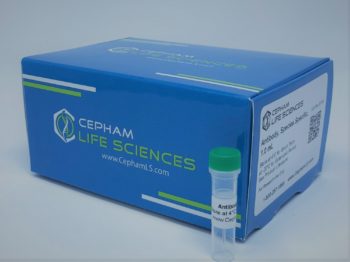Description
Aliases
Estrogen-induced tag 6, HPH-3, Hypoxia-inducible factor prolyl hydroxylase 1, HIF-PH1, HIF-prolyl hydroxylase 1, HPH-1, EGLN2, EIT6
Antibody Type
Polyclonal Antibody
Species
Human
Uniprot ID
Q96KS0
Immunogen
Recombinant human Egl nine homolog 2 protein (283-407AA)
Raised In
Rabbit
Species Reactivity
human
Tested Applications
ELISA;Not yet tested in other applications.
Background / Function
Cellular oxygen sensor that catalyzes, under normoxic conditions, the post-translational formation of 4-hydroxyproline in hypoxia-inducible factor (HIF) alpha proteins. Hydroxylates a specific proline found in each of the oxygen-dependent degradation (ODD) domains (N-terminal, NODD, and C-terminal, CODD) of HIF1A. Also hydroxylates HIF2A. Has a preference for the CODD site for both HIF1A and HIF2A. Hydroxylated HIFs are then targeted for proteasomal degradation via the von Hippel-Lindau ubiquitination complex. Under hypoxic conditions, the hydroxylation reaction is attenuated allowing HIFs to escape degradation resulting in their translocation to the nucleus, heterodimerization with HIF1B, and increased expression of hypoxy-inducible genes. EGLN2 is involved in regulating hypoxia tolerance and apoptosis in cardiac and skeletal muscle. Also regulates susceptibility to normoxic oxidative neuronal death. Links oxygen sensing to cell cycle and primary cilia formation by hydroxylating the critical centrosome component CEP192 which promotes its ubiquitination and subsequent proteasomal degradation. Hydroxylates IKBKB, mediating NF-kappaB activation in hypoxic conditions. Target proteins are preferencially recognized via a LXXLAP motif.
Isotype
IgG
Conjugate
FITC
Storage Buffer
Preservative: 0.03% Proclin 300
Constituents: 50% Glycerol, 0.01M PBS, PH 7.4
Form
Liquid
Storage
Shipped at 4°C. Upon delivery aliquot and store at -20°C or -80°C. Avoid repeated freeze.
Purity
Caprylic Acid Ammonium Sulfate Precipitation purified
Research
Cancer
Literature
[1]”PHD1 links cell-cycle progression to oxygen sensing through hydroxylation of the centrosomal protein Cep192.”Moser S.C., Bensaddek D., Ortmann B., Maure J.F., Mudie S., Blow J.J., Lamond A.I., Swedlow J.R., Rocha S.Dev. Cell 26:381-392(201Additional information
| Size | 50μg, 100μg |
|---|


